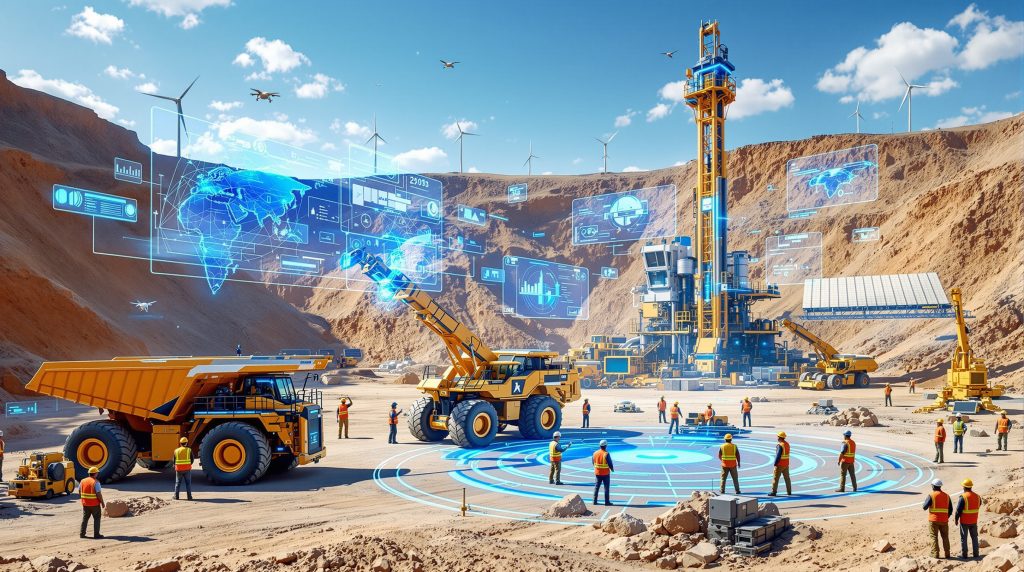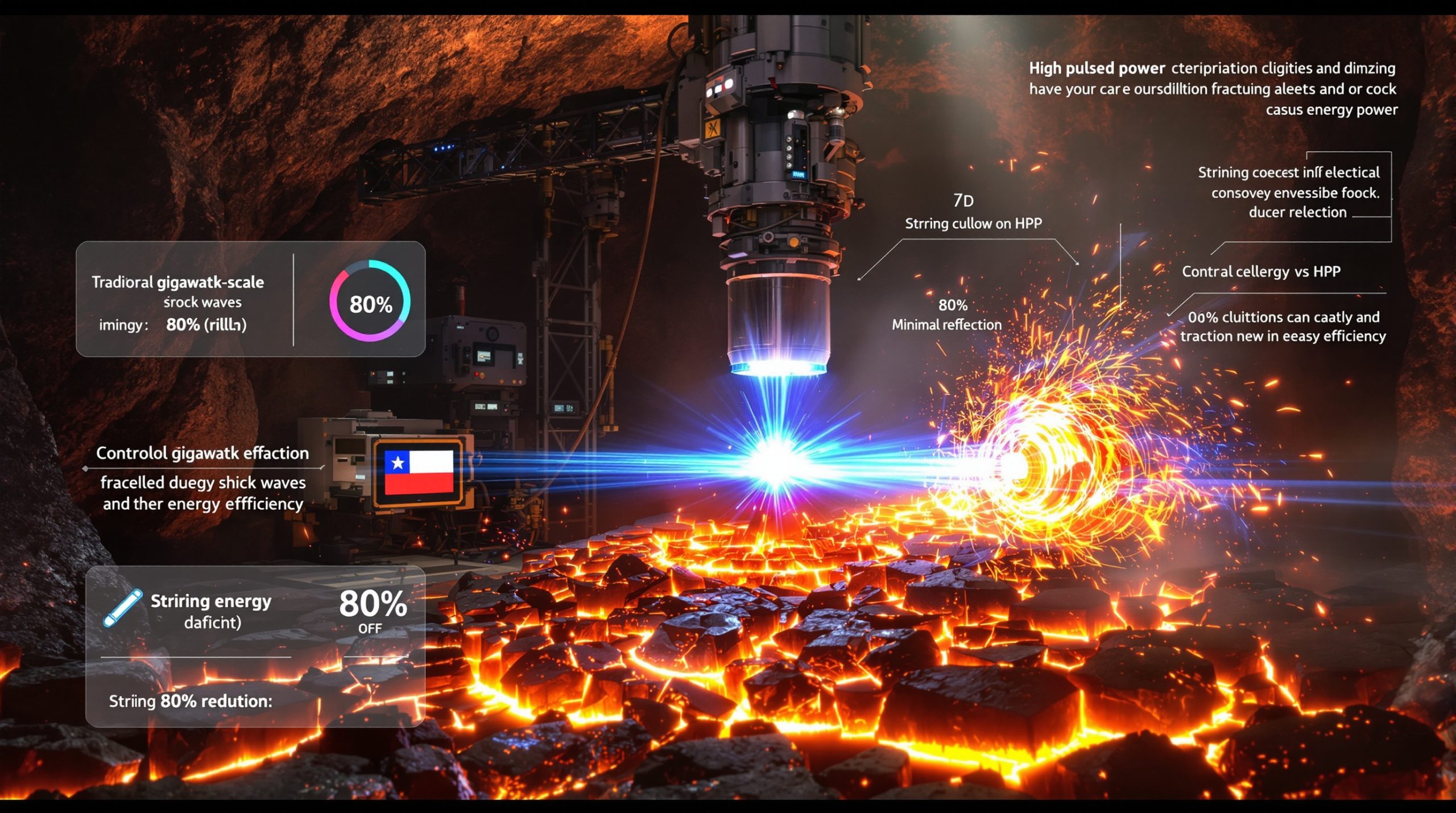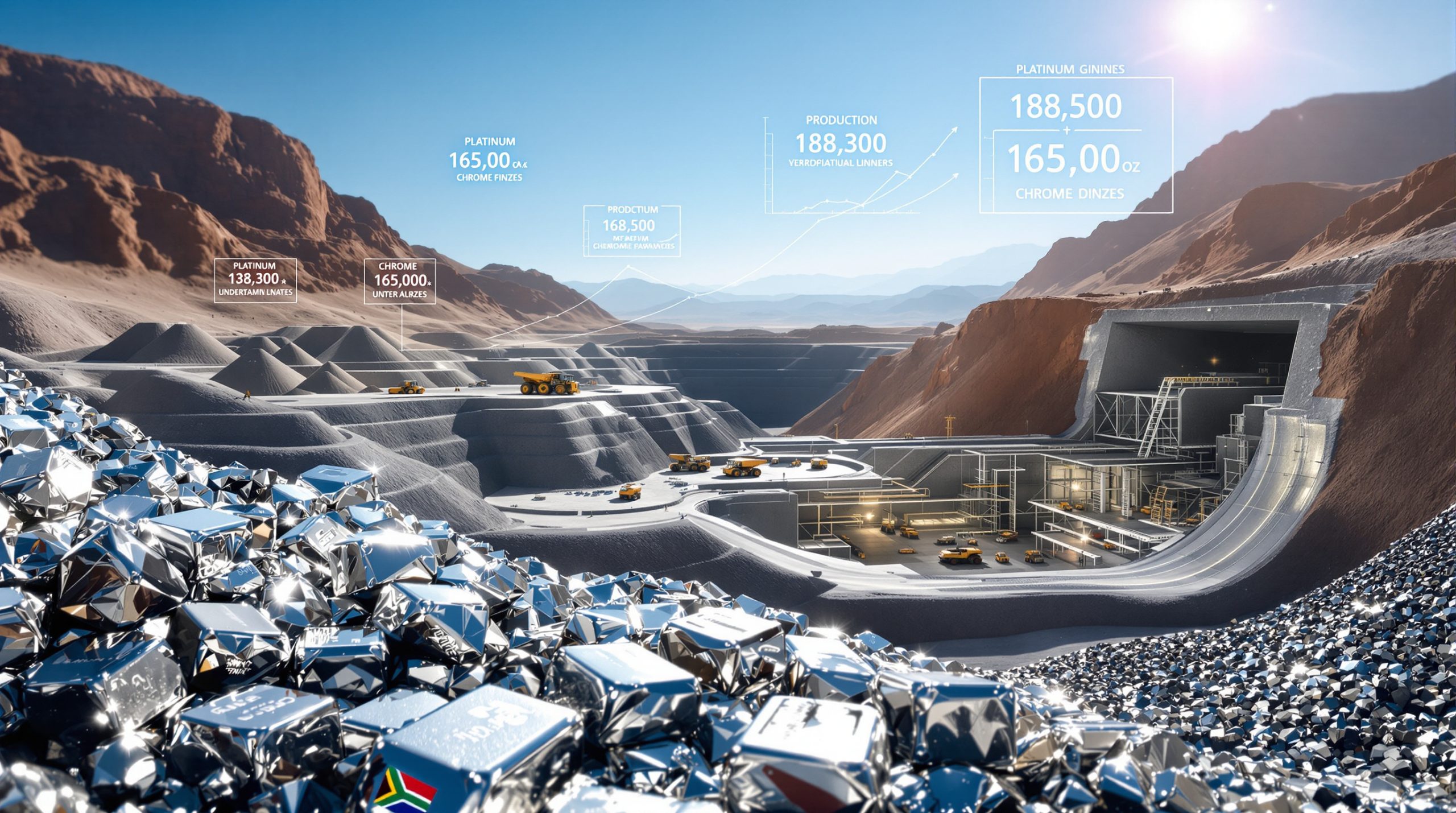How Are Technological Innovations Revolutionizing the Mining Industry?
The mining sector is experiencing a profound transformation driven by technological innovation. What was once a labor-intensive industry with significant safety concerns has evolved into a high-tech powerhouse leveraging automation, artificial intelligence, and digital connectivity. This shift is reshaping productivity standards, safety protocols, and sustainability metrics across global mining operations.
According to recent industry data, mining companies have increased their technology investments by an impressive 93%, with 44% of organizations reporting significant spending growth. This surge in digital adoption reflects the sector's recognition that technological innovations in mining are no longer optional but essential for maintaining competitiveness and operational resilience.
The driving forces behind this transformation extend beyond mere efficiency gains. Mining operations face increasing pressure from stakeholders to improve environmental performance, enhance worker safety, and maximize resource recovery—all challenges that technology can help address. These innovations are particularly critical as ore bodies become more complex and remote, requiring more sophisticated extraction and processing methods.
What Digital Technologies Are Driving Mining's Future?
The Data Revolution in Mining Operations
At the heart of mining's technological revolution lies data—massive amounts of it. Modern data-driven mining operations generate terabytes of information from equipment sensors, geological surveys, processing plants, and environmental monitoring systems. This data deluge has created both challenges and opportunities for mining companies.
Real-time operational intelligence platforms now connect previously siloed information systems, enabling mining leaders to make data-driven decisions with unprecedented speed and accuracy. These platforms integrate data from extraction, processing, logistics, and maintenance operations to create a comprehensive view of the entire value chain.
Predictive analytics applications have proven particularly valuable, with implementations showing productivity improvements of 10-20% across various operational areas. These systems can forecast equipment failures before they occur, optimize processing parameters based on ore characteristics, and identify bottlenecks in production flows.
Digital twin technology represents another frontier, creating virtual replicas of physical mining assets for simulation and optimization. These digital models allow engineers to test operational changes or equipment modifications in a risk-free virtual environment before implementing them in the physical world, reducing both costs and disruptions.
Cloud Computing's Impact on Mining Collaboration
The adoption of hybrid cloud environments has transformed how mining companies collaborate internally and with external partners. Cloud infrastructure enables seamless integration between on-site operations and corporate headquarters while facilitating partnerships with technology providers, equipment manufacturers, and downstream customers.
According to industry analysis, cloud computing provides mining operations with:
- Enhanced disaster recovery capabilities ensuring business continuity
- Flexible scaling to accommodate operational fluctuations
- Secure data sharing accelerating innovation across supply chains
- Reduced on-site IT infrastructure requirements
- Remote access solutions supporting distributed workforce models
The transition to cloud-based systems has been particularly important for remote mining operations, where traditional IT infrastructure deployment presents significant logistical challenges. Cloud solutions allow these sites to access sophisticated applications and processing power without extensive on-site computing resources.
How Is Automation Transforming Mining Safety and Productivity?
Autonomous Equipment Deployment
Autonomous equipment represents one of the most visible manifestations of mining's technological transformation. Self-operating machines now perform many of the most dangerous and repetitive tasks in mining operations, from hauling and drilling to loading and conveying.
Rio Tinto's autonomous haul truck fleet in Australia's Pilbara region stands as a testament to this shift. With over 400 autonomous trucks operating and collectively traveling more than 1 billion kilometers without human operators, the project demonstrates both the technical feasibility and operational benefits of large-scale automation.
These autonomous systems deliver multiple advantages:
- Continuous operation without shift changes or fatigue
- Consistent performance regardless of environmental conditions
- Precise adherence to optimal routes and operating parameters
- Reduced wear and maintenance requirements
- Elimination of human exposure to hazardous environments
Autonomous drilling systems have shown particularly impressive results, improving productivity by up to 30% compared to manual operations while achieving higher precision in hole placement and depth control—critical factors for efficient blasting and fragmentation.
Implementation Challenges and Solutions
Despite their benefits, autonomous systems present significant implementation challenges. Mining companies must address several critical barriers when deploying these technologies:
- Infrastructure readiness requirements for autonomous systems
- Workforce transition strategies balancing automation with employment
- Technical support frameworks for reliable remote operation
- Integration pathways connecting legacy equipment with new technologies
- Return on investment calculations justifying significant capital expenditures
Industry leaders have found that successful automation requires a comprehensive approach rather than piecemeal implementation. This includes developing detailed site preparation plans, establishing reliable communication networks, and creating clear operational protocols for the interaction between autonomous and human-operated equipment.
What Role Does AI Play in Modern Mining Operations?
Machine Learning Applications
Artificial intelligence, particularly machine learning (ML), has emerged as a powerful tool across the mining value chain. These systems excel at identifying patterns in complex datasets that would be impossible for human analysts to detect.
In geological modeling, ML algorithms process vast amounts of exploration data to identify high-potential drilling targets with greater accuracy. These systems integrate data from core samples, geophysical surveys, satellite imagery, and historical production to create more precise ore body models, improving prediction accuracy by 15-25%.
Process optimization represents another high-value application area. AI systems continuously analyze plant performance data to identify optimal operating parameters based on changing ore characteristics, equipment conditions, and production targets. These systems can:
- Adjust grinding parameters to maximize throughput
- Optimize flotation chemistry for improved mineral recovery
- Balance crusher loading for consistent particle size distribution
- Monitor energy consumption patterns to identify efficiency opportunities
- Predict quality parameters to ensure product specifications
Maintenance prediction stands as perhaps the most widely adopted AI application in mining. These systems analyze equipment sensor data to identify potential failures before they occur, reducing unplanned downtime by 10-20% and extending equipment life by 20-40%.
Computer Vision and Recognition Systems
Computer vision technologies are transforming safety and quality monitoring in mining operations. These systems use cameras and specialized algorithms to:
- Detect potential safety hazards in real time
- Monitor personnel proximity to dangerous equipment
- Verify proper use of personal protective equipment
- Assess rock face stability in underground operations
- Identify belt tears, misalignment, or material buildup on conveyor systems
In mineral processing, computer vision systems perform automated quality control by analyzing product characteristics such as size distribution, color, and surface features. These assessments happen continuously without disrupting production flows, enabling immediate corrective action when deviations occur.
How Are IoT and Connectivity Creating Smart Mines?
Comprehensive Sensor Networks
The Internet of Things (IoT) has transformed mining operations through the deployment of comprehensive sensor networks monitoring everything from equipment performance to environmental conditions. Modern mining sites may deploy thousands of sensors across operations, creating a continuous stream of operational intelligence.
These sensor networks enable:
- Real-time equipment performance monitoring
- Environmental condition tracking across operational areas
- Worker safety monitoring through wearable technology
- Asset tracking optimizing resource utilization
- Production flow monitoring enabling immediate adjustments
The value of these systems comes not just from individual measurements but from the integration of diverse data streams. For example, correlating equipment vibration patterns with production rates and energy consumption can reveal optimization opportunities that would be invisible when examining any single parameter.
Real-Time Location Systems (RTLS)
Real-Time Location Systems represent a specialized application of IoT technology that has proven particularly valuable in mining environments. These systems track the position of personnel, equipment, and materials throughout mining operations with precision ranging from meters to centimeters depending on the technology employed.
RTLS applications include:
- Personnel positioning enhancing emergency response capabilities
- Equipment location tracking improving maintenance scheduling
- Inventory management optimizing supply chain operations
- Zone management enforcing safety protocols automatically
- Collision avoidance preventing equipment-to-equipment and equipment-to-personnel accidents
Ultra-wideband (UWB) technology has emerged as a preferred solution for indoor and underground positioning due to its accuracy within 10-30 centimeters—sufficient for proximity detection and collision avoidance applications even in confined spaces.
What Technologies Are Advancing Mining Sustainability?
Environmental Impact Reduction Technologies
As mining companies face increasing environmental scrutiny and more stringent regulations, technology has become essential for achieving sustainability goals. Precision extraction technologies represent a significant advancement, minimizing waste generation by targeting ore bodies more accurately and reducing the amount of surrounding rock disturbed during mining.
Water management technologies have proven particularly important in water-stressed regions. Modern water recycling systems can reduce freshwater consumption by 50-90% through advanced treatment processes including:
- Reverse osmosis for dissolved solids removal
- Membrane bioreactors for organic contaminant treatment
- Ion exchange systems for specific element removal
- Electrocoagulation for suspended solids separation
- Advanced oxidation for persistent compound breakdown
Energy efficiency and renewable integration technologies are transforming mining's carbon footprint. Mining operations implementing renewable energy have documented mining decarbonisation benefits with carbon emissions reductions of 20-40%. Technologies enabling this transition include:
- Solar-battery hybrid systems for remote operations
- Wind power integration for grid-connected mines
- Hydrogen fuel cells for underground equipment
- Waste heat recovery from processing operations
- Microgrids managing multiple energy sources
Data-Driven Sustainability Management
Beyond physical technologies, digital systems have transformed how mining companies manage environmental performance. Environmental monitoring dashboards provide real-time visibility into key sustainability metrics, enabling immediate intervention when parameters exceed acceptable ranges.
These systems integrate data from:
- Air quality monitoring stations
- Surface and groundwater quality sensors
- Noise and vibration monitors
- Biodiversity survey results
- Energy consumption meters
- Waste production tracking systems
Predictive modeling for environmental risk assessment represents another significant advancement. These systems analyze historical data and current conditions to forecast potential environmental impacts before they occur, allowing preventive measures rather than remediation after damage occurs.
How Is Technology Reshaping the Mining Workforce?
Changing Skill Requirements
Despite automation's advance, human workers remain essential to mining operations. Industry surveys indicate that 80% of mining companies plan to increase hiring despite technology adoption, reflecting the continuing importance of human expertise and judgment in mining operations.
However, the skill profile of mining workforces is evolving rapidly. Growing demand exists for:
- Data scientists and analytics specialists
- Automation engineers and robotics technicians
- Environmental technology specialists
- Remote operations controllers
- IT/OT integration specialists
This shift doesn't mean traditional mining skills are becoming obsolete. Rather, experienced operators who develop digital literacy find themselves in high demand, as they can bridge the gap between operational knowledge and new technologies.
Training and Development Innovations
Technology is transforming not just what mining professionals do but how they learn to do it. Virtual reality (VR) simulation has revolutionized training for hazardous operations, allowing workers to practice emergency procedures and complex tasks in realistic but risk-free virtual environments.
VR training provides several advantages over traditional methods:
- Safe practice of high-risk procedures
- Realistic simulation of equipment operation
- Consistency in training delivery across locations
- Performance tracking and assessment
- Reduced equipment downtime for training purposes
Augmented reality (AR) applications provide real-time guidance to field personnel, overlaying digital information on physical equipment to assist with maintenance procedures, troubleshooting, and quality checks. These systems can connect remote experts with on-site personnel, enabling specialist knowledge to be applied across multiple locations without extensive travel.
What Safety Enhancements Come From Mining Technology?
Advanced Safety Systems
Safety improvement represents one of the most significant benefits of mining technology adoption. Advanced safety systems have transformed risk management in mining operations, with technology-based procedures and sensors making equipment operation safer and more reliable.
Proximity detection and collision avoidance systems have proven particularly valuable. These technologies use radar, LIDAR, or radio frequency identification to create safety zones around vehicles and fixed hazards. When personnel or other equipment enter these zones, the systems trigger alerts or, in advanced implementations, automatically slow or stop equipment movement.
Wearable technology has created new possibilities for worker health and safety monitoring. Smart helmets and vests equipped with sensors can track:
- Worker location for emergency response
- Vital signs including heart rate and body temperature
- Environmental exposure to gases, dust, or noise
- Fall detection and man-down alerts
- Working time in hazardous areas
These systems not only provide immediate protection but generate comprehensive data for safety analysis and improvement initiatives. The resulting insights enable proactive safety management rather than reactive responses to incidents.
Remote Operations Reducing Risk Exposure
Perhaps the most fundamental safety advancement comes from removing personnel from hazardous environments entirely. Remote operation centers allow skilled professionals to control equipment from safe, comfortable locations far from the mining face.
Remote operations provide safety benefits through:
- Elimination of exposure to rock falls and ground failure
- Removal from dust, noise, and vibration
- Protection from extreme weather conditions
- Reduction in fatigue-related incidents
- Decreased commuting time to remote mine sites
Australia's mining industry demonstrates the impact of technology-driven safety improvements. The country's mining fatality rate dropped from 0.11 per million hours worked in 2003 to 0.02 in 2019—an 82% reduction coinciding with the widespread adoption of safety technologies and remote operations.
How Did COVID-19 Accelerate Mining Digitalization?
Pandemic-Driven Innovation
The COVID-19 pandemic created unprecedented challenges for mining operations worldwide, accelerating digital transformation timelines from years to months as companies sought to maintain production while protecting workforce health.
Remote operation capabilities that were once considered optional suddenly became essential. Mining companies rapidly deployed technologies enabling:
- Remote monitoring and control of critical equipment
- Virtual inspection and quality assurance processes
- Digital documentation and workflow management
- Contactless handover between shifts
- Virtual collaboration for technical problem-solving
Health monitoring systems integrated into existing safety frameworks, adding capabilities for:
- Contact tracing through location tracking
- Occupancy monitoring in confined spaces
- Automated temperature screening at entry points
- Digital health declarations and symptom reporting
- Ventilation system optimization for airborne risk reduction
Long-Term Strategic Shifts
Beyond these immediate responses, COVID-19 triggered fundamental reconsideration of operating models. Industry leaders cite digitalization as the second most influential factor (21%) affecting their business outlook, behind only economic conditions.
This recognition has driven investment in resilient, location-independent operating models that can withstand future disruptions. Strategic priorities include:
- Increased automation of critical production processes
- Enhanced remote monitoring and control capabilities
- Distributed control architectures reducing single points of failure
- Digital skills development across workforce segments
- Cybersecurity enhancement protecting increasingly digital operations
These investments represent not just pandemic response but strategic positioning for the industry's future—creating more resilient, efficient, and adaptable mining operations.
What Does the Mine of the Future Look Like?
Vision for Mining Operations in 2030
Industry experts envision mining operations in 2030 as fully integrated digital ecosystems with minimal human presence in hazardous areas. This transformation involves not just equipment automation but comprehensive rethinking of how mining creates value.
Key characteristics of future mining operations include:
- AI drilling innovations optimizing resource recovery and environmental performance
- Autonomous equipment fleets operating continuously with minimal human intervention
- Real-time ore body models updated continuously as extraction progresses
- Transparent supply chains verified through distributed ledger technologies
- Circular economy approaches maximizing material recovery and minimizing waste
Mining companies at the forefront of mining industry evolution are already implementing elements of this vision. They recognize that future competitiveness depends not just on resource quality but on technological capability to extract those resources efficiently and responsibly.
Transition Roadmaps
The path to this future requires strategic approaches to multiple challenges:
- Legacy infrastructure integration: Developing systems that can connect existing equipment and facilities to new digital platforms rather than requiring complete replacement
- Workforce transformation: Creating comprehensive reskilling programs that enable current employees to transition to new roles
- Regulatory evolution: Collaborating with authorities to develop frameworks that ensure safety while enabling technological innovation
- Community engagement: Involving local communities in planning for increasingly automated operations to ensure shared benefits
- Economic model development: Creating financial structures that accurately reflect both the costs and benefits of technological transformation
Mining companies are finding that successful transition requires balancing technological possibility with organizational readiness and stakeholder acceptance. Those that navigate this complexity effectively will define industry leadership in the coming decades.
What Are the Practical Applications of Data Analytics in Mining?
Operational Intelligence Applications
While conceptual discussions of mining technology often focus on autonomous equipment, the most widespread value creation comes from data analytics applications that optimize existing operations.
Predictive maintenance represents the most widely adopted application, using equipment sensor data to forecast potential failures before they occur. These systems analyze patterns in vibration, temperature, pressure, and other parameters to identify deteriorating conditions. Implementation results show:
- Equipment downtime reduction of up to 40%
- Maintenance cost decreases of 15-25%
- Spare parts inventory optimization of 20-30%
- Extended equipment life of 20-40%
Production optimization through data analytics involves analyzing the entire value chain from extraction to processing to identify bottlenecks and improvement opportunities. These systems can increase resource recovery by 5-15% by identifying optimal operating parameters for changing ore characteristics.
Energy management applications analyze consumption patterns to identify efficiency opportunities and optimize energy sources. Mining operations implementing these systems report power usage reductions of 10-20% through measures like:
- Load shifting to off-peak periods
- Motor and drive system optimization
- Compressed air system leak reduction
- Process heating efficiency improvements
- Ventilation on demand in underground operations
Implementation Best Practices
Mining companies that successfully implement data analytics follow several key practices:
- Establish clear data governance: Defining standards for data collection, storage, access, and quality assurance
- Build cross-functional teams: Combining operational expertise with data science capabilities
- Start with high-value use cases: Focusing initial efforts on applications with clear ROI
- Develop user-friendly interfaces: Ensuring insights are accessible to operational personnel
- Create continuous improvement cycles: Using implementation learnings to refine future applications
Organizations that approach analytics as an ongoing capability development rather than a one-time project achieve substantially better results. This involves building internal skills while leveraging external expertise for specialized applications.
FAQ: Mining Technology Innovations
How are mining companies measuring ROI on technology investments?
Mining organizations evaluate technology ROI through multiple frameworks that consider both quantitative metrics and qualitative benefits. Quantitative measures include:
- Productivity improvements (tons per hour, recovery rates)
- Cost reduction (per ton mined, per ounce produced)
- Equipment utilization increases (operating hours vs. downtime)
- Energy consumption reduction (kWh per ton processed)
- Safety incident frequency reduction (recordable incident rates)
Qualitative benefits often carry equal weight in evaluation frameworks:
- Enhanced operational resilience
- Improved environmental performance
- Strengthened license to operate
- Greater workforce satisfaction and retention
- Reduced compliance risk
Comprehensive frameworks consider benefits across multiple timeframes, recognizing that some technologies deliver immediate efficiency gains while others build long-term capabilities essential for future competitiveness.
What cybersecurity challenges do digital mining operations face?
As mining operations become increasingly connected, they face expanding cybersecurity risks. Key challenges include:
- Operational technology (OT) vulnerabilities in equipment control systems
- Remote access security for distributed operations
- Integration security between IT and OT environments
- Legacy systems with limited security capabilities
- Physical-cyber attack vectors in remote locations
Mining companies are implementing comprehensive security frameworks that include:
- Network segmentation between business and operational systems
- Multi-factor authentication for critical system access
- Regular vulnerability assessments and penetration testing
- Employee security awareness training
- Incident response planning specific to mining environments
The industry increasingly recognizes cybersecurity as a safety-critical function rather than just an IT responsibility, reflecting the potential operational impacts of security breaches.
How are mining companies addressing connectivity in remote locations?
Mining operations in remote areas deploy multiple connectivity solutions to ensure reliable communication:
- Private LTE/5G networks providing site-wide coverage
- Satellite communications for remote locations
- Mesh networks connecting mobile equipment
- Edge computing reducing dependence on central connectivity
- Redundant backhaul links ensuring continuous operation
These technologies ensure critical systems remain operational even with intermittent connectivity to central infrastructure. Advanced implementations include dynamic prioritization of network traffic during bandwidth constraints, ensuring safety-critical and production-essential communications receive preference.
What role does blockchain play in modern mining?
Blockchain applications in mining focus primarily on supply chain transparency and material provenance verification. These systems create immutable records documenting material origin, processing, and transfer throughout the value chain.
Key applications include:
- Mineral provenance verification ensuring ethical sourcing
- Product certification for premium pricing (conflict-free, responsibly produced)
- Automated contract execution through smart contracts
- Regulatory compliance documentation
- Equipment maintenance history verification
Mining companies implementing blockchain solutions report benefits including premium pricing for verified products, reduced compliance documentation costs, and enhanced stakeholder trust through transparent reporting. Furthermore, implementing a modern mine planning process that incorporates blockchain can significantly improve transparency throughout the mining lifecycle.
Ready to Stay Ahead of Mining's Technological Revolution?
Discover significant mineral opportunities before the market with Discovery Alert's proprietary Discovery IQ model, delivering real-time notifications of major ASX announcements and transforming complex data into actionable insights. Explore how historically significant discoveries have generated substantial returns by visiting Discovery Alert's dedicated discoveries page and position yourself to capitalise on the next mining innovation breakthrough.




